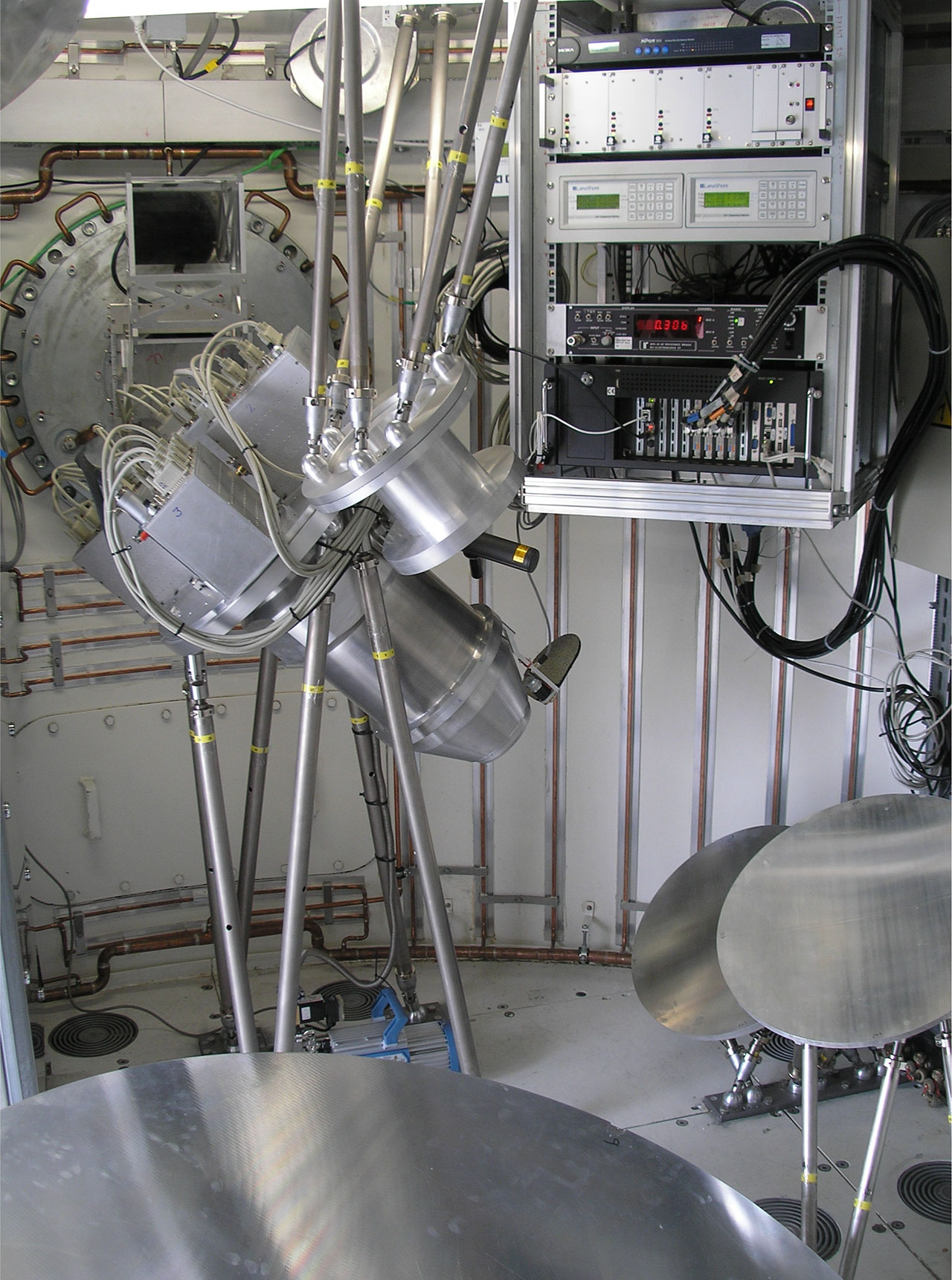Early years
The Atacama PathFinder EXperiment (APEX) started as a collaboration among the Max-Planck-Institut für Radioastronomie (MPIfR), the Onsala Space Observatory (OSO) and the European Southern Observatory (ESO). Chile, as a host country, has access to 10% of the telescope observing time and ESO is in charge of the operation in Chile.
The memorandum of understanding was signed in July 2001, and the design and construction was contracted to VERTEX Antennentechnik GmbH. Construction started in spring 2003 and telescope commissioning commenced in spring 2004.

APEX was officially inaugurated in Sep 25th, 2005, after a period of commissioning and Science Verification. You can see here some pictures from the inauguration.
In parallel to the build up of the telescope, an ambitious instrument development program had started at the partner institutions with the goal of maximising the exploitation of the observable windows in Chajnantor.
The antenna was accepted in July 2005 followed by a block of Science Verification observations from July 13 to August 3. The first incarnation of FLASH was the workhorse for the commissioning of the telescope and, later on, for a number of science goals in the higher sub-mm atmospheric windows. Soon after, the APEX-2A receiver followed, completing the first generation of heterodyne instruments at APEX. These were working in combination with the first generation of digital spectrometers, with 1 GHz bandwidth and supporting resolutions of 16 k-channels.
To know more…
Start of operations
Science operations started on August 18, 2005. The observing schedule was divided in blocks for each partner (just like now), and observations started with ESO time. In total 103 days of observations were performed until December 23 when the summer shutdown started. The CONDOR 1.5 THz receiver was installed in November with successful observations of the CO(13-12) line at about 1.5 THz in Orion.
During the 2006 summer shutdown the first installation of the APEX-SZ bolometer was done as well as the installation and commissioning of the new FFTS spectrometer and IF system (2 x 1 GHz). The new, oxygenated, control room containers on Chajnantor started to be used, improving the environment for staff performing science operations from the site. A morning shift with observations from Chajnantor was introduced to increase the amount of observing time per day. Observations started in April with a block of MPIfR time. During 2006 in total 220 days of observations was done with an average of 13.5h/day using APEX-2A and FLASH.

In September 2006 the powerful LABOCA bolometer camera was delivered by the MPIfR bolometer group as a facility instrument to cover the 0.87 mm window. During the following year the commissioning works and some improvements would be done.
It would be followed by ASZCA, a PI camera result of the collaboration between the MPIfR and the UC Berkeley, and CHAMP+ the first array of heterodyne receivers, with dual colour capabilities and aimed at exploring the high frequency sub-mm windows.
In the summer shutdown of 2017 the successful commissioning of the wobbler was also taking place. Holography was done before and after the wobbler installation, and the surface reached an accuracy of 12.9 microns. LABOCA was commissioned in May followed by a week of science verification observations.
Later, in the spring of 2008, SHeFI was the second big facility instrument delivered to APEX. Built by the GARD group in Sweden it would cover 3 atmospheric bands, those centred at 230, 345 and 460 GHz, respectively. This was followed by SABOCA, another development by the MPIfR bolometer group using TES technology. This facility instrument covering the 0.35 mm atmospheric window. Almost in parallel, LABOCA was complemented by PolKa, making this combination a powerful polarimeter for continuum emission.
To know more…
Operations around the clock
With the advent of powerful and versatile facility instrumentation, APEX started to combine its experimental role (to test state-of-the art PI instrumentation) with more streamlined scientific observing. The combination of LABOCA, SHeFI and SABOCA made APEX a versatile facility to produce new and exciting science. And complemented with the exciting capabilities of PI instruments.
In 2009, it was decided to switch from a 16-h operations plan (night and mornings when weather conditions are best) to a more efficient 24-h operations plan, making use of afternoons. This resulted in an optimisation of the antenna usage and a substantial increase in the number of hours on sky. Daytime observations were conducted from the high site in Chajnantor while night operations were from Sequitor.
In 2013 arrived to APEX the ArTéMiS dual-color continuum camera, developed by CEA (Saclay), designed to cover the 0.35 and 0.45 mm windows. This was possible thanks to the experience gained with the prototype instrument (p-ArTéMiS), which was successfully tested some years earlier at APEX.
To know more…
Sciops-R(emote) operations
The next big step arrived with the possibility to conduct science operations fully remotely from the Sequitor base in San Pedro de Atacama. This was possible with major hardware upgrades on the antenna drive system and the design and implementation of a failsafe remote-control system that ensures the safety of the antenna (the so-called Sun Avoidance System, SAS).

Sciops-R(emote) operations started successfully in 2017 and it has been the regular operational model since then. The control room in Sequitor became the operations centre for Sciops and Engineering activities.
To know more…
APEX-OP23+
2022 marked the end of an era for APEX as the OSO / ESO / MPIfR fruitful partnership also ended with that year.
However, APEX did not end here, but changed, entering into a different era, with a different form of operation (the APEX-OP23+), now under the lead of the MPIfR.